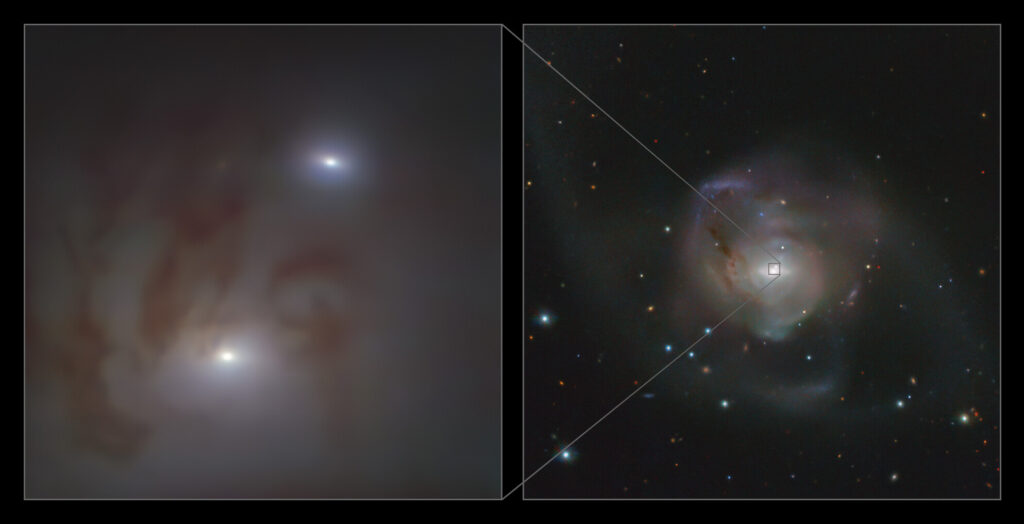With the help of the European Southern Observatory's (ESO) Very Large Telescope (VLT), astronomers have discovered the closest pair of supermassive black holes found to date.
The two objects also have a much smaller separation than any other pair of these objects discovered so far, which points to their eventual merger into a single giant black hole.
Situated in galaxy NGC 7727, in the constellation Aquarius, the pair of supermassive black holes lies approximately 89 million light-years away from Earth. Despite looking distant, this pair by far beats the proximity record for such a system, which was 470 million light-years away, thus making it the closest known pair of black holes to us.
Supermassive black holes lurk at the heart of massive galaxies and when two of these galaxies merge, their black holes end up on a collision course. The pair in NGC 7727 also sets the record for the smallest known separation between two supermassive black holes, as we've observed them only 1600 light years apart.
"This is the first time we've found two supermassive black holes so close to each other, actually less than half the distance previously known for such objects," says Karina Voggel, an astronomer at the Strasbourg Observatory, France, and main author of study published online in the specialist journal Astronomy & Astrophysics.
"The small separation and velocity of the two black holes indicates that these objects will merge into a single giant black hole, probably in the next 250 million years," adds co-author Holger Baumgardt, professor at the University of Queensland, Australia.
The fusion of black holes like these could explain the existence of the most massive black holes in the Universe.
Voggel and his team were able to determine the masses of the two objects by looking at how the gravitational pull of black holes influences the motion of the stars that surround them.
The largest black hole, located at the very center of NGC 7727, has a mass of nearly 154 million times the mass of our Sun, while its companion has a mass of 6,3 million times the mass of the Sun.
This is the first time that the masses of a pair of supermassive black holes have been measured in this way, something only possible due to the proximity of this system to Earth and the detailed observations that the team obtained at the Paranal Observatory, in Chile, with MUSE ( Multi-Unit Spectroscopic Explorer), an instrument mounted on ESO's VLT, which Voggel learned to work with during his time as a student at ESO.
Measuring masses with MUSE and using additional data obtained with the NASA/ESA Hubble Space Telescope allowed the team to confirm that the objects in NGC 7727 are indeed supermassive black holes.
Astronomers previously suspected that this galaxy harbors two black holes, however their presence has not yet been confirmed, as large amounts of high-energy radiation emitted in its vicinity are not observed, which would be a sure indication of its presence.
"Our discovery implies that there may be many more of these fused galaxy relics that may contain many massive black holes waiting to be discovered," says Voggel, "which could increase the total number of supermassive black holes in the local Universe by 30% ».
The search for such hidden supermassive black hole pairs is sure to take a big step forward with ESO's Extremely Large Telescope (ELT), slated to begin operations later this decade in the Chilean Atacama Desert.
"This detection of a pair of supermassive black holes is just the beginning," says Steffen Mieske, ESO astronomer in Chile and Head of Scientific Operations at Paranal.
“With the HARMONI instrument, which will be mounted on the ELT, we will be able to detect objects like this but much further away than is currently possible. ESO's ELT will therefore be crucial for us to understand these objects,” he concludes.





















Comments